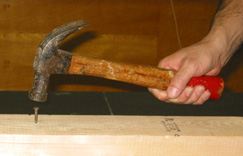
Let's analyze the hammer hitting the nail again, from the point of view of energy. The problem is that it takes a large force to drive the nail into the wood.
Using a hammer solves the problem, in several ways. We are using our arm
muscle to get the hammer moving, instead of our fingers. We give energy to
the hammer over a large distance, as we swing the hammer towards the nail.
Recall that
Energy transferred = force x distance
and now both the force and the distance are large.
The hammer is massive, and thus will store the energy as kinetic energy without
having to go too fast.
For example, the steel head of a household hammer weighs 1 pound, and thus
its mass is 0.45 Kg. When it is moving 2 m/sec, it has kinetic energy:
Kinetic energy = 1/2 (0.45 Kg)(2 m/sec)2 = 0.9 J
To give it this much energy (starting from rest), we only need to exert
a small force over a small distance. In fact, just letting the hammer fall
0.2 m is sufficient, because the hammer weighs 4.5 N:
Energy transferred = force x distance = 4.5 N x 0.2 m = 0.9 J
This energy comes from the gravitational potential energy, which we
provided when we lifted the hammer to its starting position.
Applying a larger force or making the hammer swing farther will give a
correspondingly more energetic hammer.
Let's return to the problem of getting the nail into the board. We need
a large force, and we have a little energy.
Energy is not the same as force. But they are related by
Energy transferred = force x distance
As the hammer hits the nail, all of its energy is removed (it comes to a stop!).
It is transferred to the nail, which then gives it to the wood (turning it into
other forms in the process). During this transfer, the nail moves
a small distance; then this relationship allows us to realize how large the force
must be:
force = energy transferred/distance
For example, if the hammer has energy 0.9 J and the nail only moves 0.002 m
when the hammer hits it, the force was
force = 0.9 J/0.002 m = 450 N
which is about how much you weigh. If you could stand balanced on one toe on the nail, you might not need a hammer.
Check the box when you are done:
Discussion of kinetic and potential energy